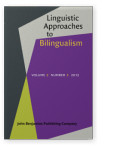Commentary
A lifespan perspective on individual differences in grammatical abilities
References (18)
Bishop, D.V.M., Adams, C.V., & Norbury, C.F.
(
2006)
Distinct genetic influences on grammar and phonological short-term memory deficits: Evidence from 6-year-old twins.
Genes, Brain, and Behavior, 51, 158–169.


Gleitman, L., & Gleitman, H.
(
1970)
Phrase and Paraphrase: Some Innovative Uses of Language. New York: Norton & Company.

Hadley, P., & Holt, J.
(
2006)
Individual differences in the onset of tense marking: A growth curve analysis.
Journal of Speech, Language, and Hearing Research, 491, 984–1000.


Hadley, P., & Short, H.
(
2005)
The onset of tense marking in children at-risk for SLI.
Journal of Speech, Language, and Hearing Research, 481, 1344–1362.


Hadley, P., Rispoli, M., Fitzgerald, C., & Bahnsen, A.
(
2011)
Predictors of morphosyntactic growth in typically developing toddlers: Contributions of parent input and child sex.
Journal of Speech, Language, and Hearing Research, 541, 549–566.


Johnson, C., Beitchman, J., Young, A., Escobar, M., Atkinson, L., Wilson, B., Brownlie, E., Douglas, L., Taback, N., Lam, I.
(
1999)
Fourteen-year follow-up of children with and without speech/language impairments: Speech/language stability and outcomes.
Journal of Speech, Language, and Hearing Research, 421, 744–761.


Law, J., Rush, R., Schoon, I., & Parsons, S.
(
2009)
Modeling developmental language difficulties from school entry into adulthood: Literacy, mental health, and employment outcomes.
Journal of Speech, Language and Hearing Research, 521, 1401–1416.


Miller, B., & McCardle, P.
(
2011)
Moving closer to a public health model of language and learning disabilities: The role of genetics and the search for etiologies.
Behavior Genetics, 411, 1–5.


Newbury, D., Paracchini, S., Scerri, T., Winchester, L., Addis., L., Richardson, A., Walter, J., Stein, J., Talcott, J., & Monaco, A.
(
2011)
Investigation of dyslexia and SLI risk variants in reading and language-impaired subjects.
Behavior Genetics, 411, 90–104.


Rice, M., Hoffman, L., & Wexler, K.
(
2009)
Judgements of omitted BE and DO in questions as extended finiteness clinical markers of specific language impairment (SLI) to 15 years: A study of growth and asymptote.
Journal of Speech, Language and Hearing Research, 521, 1417–1433.


Rice, M., Smith, S., & Gayan, J.
(
2009)
Convergent genetic linkage and associations to language, speech and reading measures in families of probands with Specific Language Impairment.
Journal of Neurodevelopmental Disorders, 11, 264–282.


Rice, M., Tomblin, J., Hoffman, L., Richman, W., & Marquis, J.
(
2004)
Grammatical tense deficits in children with SLI and non-specific language impairment: Relationships with nonverbal IQ over time.
Journal of Speech, Language, and Hearing Research, 471, 816–834.


Rice, M., Wexler, K., & Hershberger, S.
(
1998)
Tense over time: The longitudinal course of tense acquisition in children with specific language impairment.
Journal of Speech, Language and Hearing Research, 411, 1412–1431.


Rice, M., Wexler, K., & Redmond, S.
(
1999)
Grammaticality judgments of an extended optional infinitive grammar: Evidence from English-speaking children with specific language impairment.
Journal of Speech, Language, and Hearing Research, 421, 943–961.


Rispoli, M., Hadley, P., & Holt, J.
(
2009)
The growth of tense productivity.
Journal of Speech, Language, and Hearing Research, 521, 930–944.


Snowling, M., Adams, M., Bishop, D., & Stothard, S.
(
2001)
Educational attainments of school leavers with prehistory of SLI.
International Journal of Language and Communication Disorders, 361, 173–183.


Stothard, S., Snowling, M., Bishop, D., Cbipchase, B., & Kaplan, C.
(
1998)
Language impaired preschoolers: A follow-up into adolescence.
Journal of Speech, Language, and Hearing Disorders, 411, 407–418.


Tomblin, J., Freese, P., & Records, N.
(
1992)
Diagnosing specific language impairment in adults for the purpose of pedigree analysis.
Journal of Speech, Language & Hearing Research, 351, 832–843.


